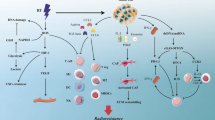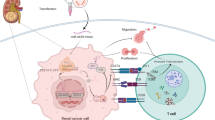Abstract
Background
Many patients with esophageal squamous cell carcinoma (ESCC) are inoperable due to old age or advanced stage; thus, radio- and chemotherapy are considered the standard treatments for these patients. However, due to the radiation resistance of tumor cells that may arise during radiotherapy, results are still not satisfactory. The authors’ previous studies found that microRNA can affect radiosensitivity, and further microRNA research was conducted to improve the radiosensitivity of ESCC.
Methods
Cells were treated with silent miR-29b (si-miR-29b). Thereafter,proliferation, colony formation, cell cycle, and apoptosis were determined. The luciferase reporting assay was used to confirm the direct interaction between miR-29b and BTG2. Serum samples and clinical follow-up data of 75 elderly or advanced ESCC patients who could not tolerate surgery were collected.
Results
The expression level of miR-29 in ESCC serum was closely correlated to radiosensitivity (χ2 =8.36, p < 0.05) and correlated with overall survival (OS; hazard ratio [HR] 0.47, 95% confidence interval [CI] 0.24–0.90). Function assays demonstrated that the number of cell clones increased after radiometry radiation, and the cell cycle was blocked in the G0/G1 phase (from 37.2 to 56.9%) in the si-miR-29b transfection group. Expression of BTG2 was upregulated and expression of cyclin D1 was downregulated (p < 0.05). Transfection of si-BTG2 can reverse this result and restore the expression level of cyclin D1 (p < 0.05). The target gene BTG2 of miR-29b was predicted using a bioinformatics tool and confirmed by dual-luciferase reporter assay.
Conclusion
Silencing of miR-29b in ESCC cells can increase expression of BTG2 and decrease the level of intracellular cyclin D1, resulting in cell cycle arrest and accumulation in the G0/G1 phase. Because G0/G1-phase cells are insensitive to radiotherapy, the sensitivity of radiotherapy is reduced.



Similar content being viewed by others
References
Wong M et al (2018) Global Incidence and mortality of oesophageal cancer and their correlation with socioeconomic indicators temporal patterns and trends in 41 countries. Sci Rep 8(1):4522
Jin J et al (2020) Methylation-associated silencing of miR-193b improves the radiotherapy sensitivity of esophageal cancer cells by targeting cyclin D1 in areas with zinc deficiency. Radiother Oncol 150:104–113
Qi Y, Li X, Zhao S (2015) miR-29b inhibits the progression of esophageal squamous cell carcinoma by targeting MMP‑2. Neoplasma 62(3):384–390
Samiei H et al (2019) Dysregulation of helper T lymphocytes in esophageal squamous cell carcinoma (ESCC) patients is highly associated with aberrant production of miR-21. Immunol Res 67(2–3): p:212–222
Kwon JJ et al (2016) Novel role of miR-29a in pancreatic cancer autophagy and its therapeutic potential. Oncotarget 7(44):71635–71650
Yang Z et al (2019) CSB affected on the sensitivity of lung cancer cells to platinum-based drugs through the global decrease of let‑7 and miR-29. BMC Cancer 19(1):948
Guo Y et al (2019) Improved radiotherapy sensitivity of nasopharyngeal carcinoma cells by miR-29-3p targeting COL1A1 3′-UTR. Med Sci Monit 25:3161–3169
Mao A et al (2020) MicroRNA-29b-3p enhances radiosensitivity through modulating WISP1-mediated mitochondrial apoptosis in prostate cancer cells. J Cancer 11(21):6356–6364
Zhang T, Xue X, Peng H (2019) Therapeutic delivery of miR-29b enhances radiosensitivity in cervical cancer. Mol Ther 27(6):1183–1194
Qian D et al (2014) Inhibition of human positive cofactor 4 radiosensitizes human esophageal squmaous cell carcinoma cells by suppressing XLF-mediated nonhomologous end joining. Cell Death Dis 5:e1461
Zhu D et al (2020) A biomimetic nanozyme/camptothecin hybrid system for synergistically enhanced radiotherapy. J Mater Chem B 8(24):5312–5319
Miyata H et al (2000) CDC25B and p53 are independently implicated in radiation sensitivity for human esophageal cancers. Clin Cancer Res 6(12):4859–4865
Yin H et al (2020) UBE2T promotes radiation resistance in non-small cell lung cancer via inducing epithelial-mesenchymal transition and the ubiquitination-mediated FOXO1 degradation. Cancer Lett 494:121–131
Ma SQ et al (2017) The lack of Raf‑1 kinase feedback regulation enhances antiapoptosis in cancer cells. Oncogene 36(14):2014–2022
Boiko AD et al (2006) A systematic search for downstream mediators of tumor suppressor function of p53 reveals a major role of BTG2 in suppression of Ras-induced transformation. Genes Dev 20(2):236–252
Yuniati L et al (2019) Tumor suppressors BTG1 and BTG2: beyond growth control. J Cell Physiol 234(5):5379–5389
Acknowledgements
Thanks to my mentors for their guidance. Thanks to all the patients who participated in this study and the medical staff of the Fourth Hospital of Hebei Medical University for collecting blood from the patients.
Funding
This study was supported by grants from the National Natural Scientific Foundation of China (81871922).
Author information
Authors and Affiliations
Corresponding author
Ethics declarations
Conflict of interest
D. Guo, J. Jin, J. Liu, X. Dong, D. Li, and Y. He declare that they have no competing interests.
Ethical standards
All procedures performed in studies involving human participants or on human tissue were in accordance with the ethical standards of the institutional (Human Ethics Committee of the Fourth Hospital of Hebei Medical University) and/or national research committee and with the 1975 Helsinki declaration and its later amendments or comparable ethical standards. Informed consent was obtained from all individual participants included in the study.
Rights and permissions
About this article
Cite this article
Guo, D., Jin, J., Liu, J. et al. MicroRNA-29b regulates the radiosensitivity of esophageal squamous cell carcinoma by regulating the BTG2-mediated cell cycle. Strahlenther Onkol 197, 829–835 (2021). https://doi.org/10.1007/s00066-021-01790-5
Received:
Accepted:
Published:
Issue Date:
DOI: https://doi.org/10.1007/s00066-021-01790-5




